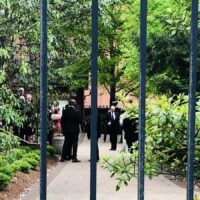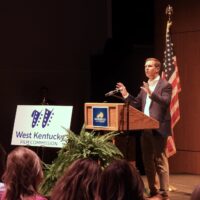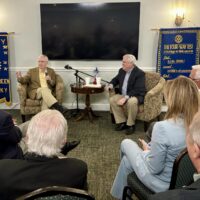The U.S. has destroyed its last chemical weapon. It’s been decades in the making.
The more than 500 tons of nerve and mustard agent had been stored at the Blue Grass Army Depot for all those years.
It was a nerve agent rocket that was the last to be neutralized says Candice Coyle, as she thanked workers at the plant she supervises.

“The amount of work that they have done cannot be gathered in one moment. I think some of us just woke up this morning thinking what have we accomplished,” said Coyle.
The momentous event happened Friday and fulfills an international treaty signed by many countries in the 90s.
For many central Kentuckians, it goes back to 1984. That’s when Army officials proposed just burning tons of mustard and nerve munitions, some of it dating back to World War I. The public pushback was quick and firm and successful, led in part by Craig Williams, director of the Kentucky Environmental Foundation.
“We had a very diverse group of people in this dialogue and the atmosphere at first was somewhat tense, but as we had meeting, after meeting, after meeting … people began to work together,” said Williams
In the end, neutralization rather than incineration was the chosen method. So it took decades for the weapons to actually be destroyed. In fact that didn’t start until 2019. The delays were due in part because money was needed to build a 16-acre plant to dismantle the rockets and projectiles. Coyle says the planning paid off.
“We were very safe during this entire thing. We’ve been very diligent in making sure people are focused on safety and making that our priority,” said Coyle.
With the milestone of the last rocket, the 1,500 people who work at the plant are not finished with the job says Ron Hink, a project manager for the contractor Bechtel Parsons.
“Sports analogy, it’s like you had a really good season and you kind of hate to see it end because the performance was really good … had a good team on the field, but then you realize there’s another season coming behind it, we still have a lot of flushing, we have agent batches to run,” said Hink.
The residual of these chemical agents in the warheads still needs to be dealt with, which could take a year or so, but the 1997 international treaty agreement, calling for the elimination of chemical weapons is finally fulfilled says Paul Walker, with the Arms Control Association.
“I think it’s an extraordinary period of destroying every last weapon in a whole category of weapons of mass destruction,” said Walker.
The total cost for the U.S. to comply with the chemical weapons convention is more than 40 billion dollars. But some countries did not sign the treaty. Walker says North Korea, for one, still has chemical weapons. However, he doesn’t see the countries who have signed on to dramatically change course.
“I’m not worried about building a big stockpile that could be suddenly sprung on somebody because that can be inspected and verified by satellite and the like,” said Walker.
Over the years there were eight chemical weapons stockpiles eliminated across the country. In late June, a plant in Pueblo Colorado finished its mission and the Blue Grass Army Depot is planning an official celebration later this year.






